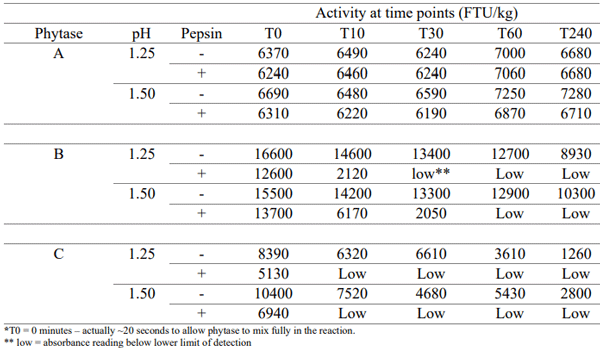I. INTRODUCTION
Exogenous enzymes are susceptible to denature when exposed to low-pH conditions, normally prevailing in the gastric phase. Hence, resistance to low-pH is considered one of the key criterion for the suitability of commercial phytase enzymes for animal feed application. The pH-stability is assessed in-vitro by measuring the recovery of enzyme activity after exposing enzyme protein to low-pH buffers. To mimic gizzard conditions, pH 2.5-3.5 with added pepsin is often employed as the standard for these assays (Menezes-Blackburn et al. 2015). Using realtime measurement of pH over time in live individual broiler chickens, Lee et al. (2017) noted that gizzard pH was not a constant and, invariably, fell below 1.5 or even 1.0. These observations were considerably lower than those representing published estimates of average gizzard pH in poultry (Svihus, 2011) and posed a question if the conventional method of measuring pH in killed birds was confounded by the post-mortem changes. It also warrants a reevaluation of pH-stability of commercial phytases at more realistic low-pH conditions. This communication presents results of an in-vitro assay designed to study the behavior of three commercial phytases under two assay pH conditions i.e., 1.25 and 1.5, each with or without pepsin.
II. METHOD
Reactions were carried out in 100mM glycine-HCl buffer pH 1.25 or pH 1.5 containing 2g/l BSA. 1g of pepsin (Sigma P7000) was dissolved in 60ml of glycine buffer (pH 2.5) and frozen in 1.5ml aliquots. 1ml of the frozen aliquot was diluted in 25ml glycine buffer pH 1.25 or pH 1.50 and 5ml of the dilution was added to the reaction.
The final pepsin concentration was 3.33mg in the 50ml reaction. The reactions were carried out on a multi-stirrer plate in a water bath at 40⁰C.At T0, 1ml of enzyme dilution was added to each reaction (50ml total). The sample was left to stir for ~20 seconds to allow the enzyme to be distributed evenly throughout the reaction before 1ml was taken and stopped in 4ml pH 5.5 acetate buffer on ice. Samples (1ml) were then taken (and stopped in 4ml pH 5.5 acetate buffer on ice) at 10, 30, 60 and 240 minutes. Phytase activity was determined by incubating the enzyme solution sodium phytate at pH 5.5 and 37°C, liberating inorganic phosphate from the substrate. The reaction is terminated by the addition of an acid molybdate / vanadate reagent which also produces a coloured complex with the phosphate produced. The colour of the yellow vanado-molybdo-phospho-complex, which is a measure of the amount of phosphate released, is measured at a wavelength of 415 nm and related to a phosphate standard curve.
III. RESULTS & DISCUSSION
Phytases differ significantly in their ability to withstand low pH conditions. Phytase A retained its activity at both pH’s, with or without pepsin, and at all time intervals. In the presence of pepsin, phytase B lost 80 and 50% of its activity, respectively at pH 1.25 and 1.5 at as early as T10. The activity fell further and went below the limit of detection at T30 and T60, respectively at pH 1.25 and 1.5. Phytase B showed a fair degree of stability in the absence of pepsin as reflected by residual activity of ~50 and ~65% at T240, respectively at pH 1.25 and 1.5. In the presence of pepsin, phytase C was below the limit of detection at T10, independent of the assay pH. Phytase C displayed weak resilience to pH in the absence of pepsin and retained ~15 and 27% of its initial activity at T240, respectively at pH 1.25 and 1.5.
These data suggest that conventional pepsin stability tests may erroneously suggest a phytase is stable under the conditions prevailing in the gizzard when it may not be and thus this warrants further investigation. Furthermore, feeding practices and/or dietary ingredients which alter the pH minimum encountered in the gizzard likely degrade the stability of some phytases far more than others.
Table 1 - Activities of phytases at different time points (0, 10, 30, 60 and 240 minutes), pH (1.25 or 1.50), with/without pepsin.
Presented at the 34th Annual Australian Poultry Science Symposium 2023. For information on the latest edition, click here. 








